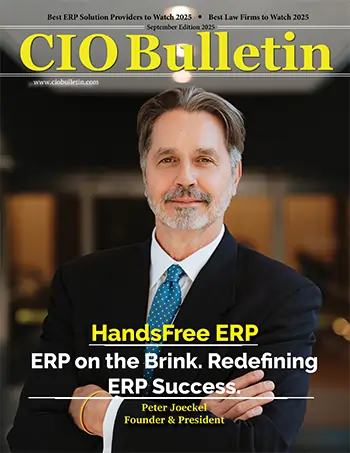CIO Bulletin

In the domain of modern security solutions tailored for enterprises, Airgap Networks emerges as a standout provider, specializing in Zero Trust security and networking services. With a keen focus on bolstering cybersecurity defenses while optimizing operational efficiency, Airgap offers managed Software as a Service (SaaS) solutions designed to minimize attack surfaces and seamlessly integrate into existing network infrastructures.
What distinguishes Airgap from its competitors is its fully cloud-managed platform, delivering essential features such as secure access, microsegmentation, and asset discovery straight out of the box—all without the need for cumbersome agents. This agentless approach ensures swift deployment in mere hours, making it the most cost-effective solution for organizations seeking instant risk reduction and compliance enhancement across their networks.
In an exclusive interview with CIO Bulletin, Ritesh Agrawal, CEO of Airgap Networks, shared insights on how his company, with its blend of cutting-edge technology, ease of deployment, and extensive global reach, emerges as a top contender in providing Zero Trust security and networking services for today’s enterprises.
The Inception of Airgap Networks
Drawing from their collective experiences, Ritesh Agrawal and his team identified a significant gap in cybersecurity: traditional solutions were struggling to keep pace with the increasing complexity of enterprise networks. They observed that older systems, initially designed without security considerations, were now causing issues. As enterprise LANs emerged as prime targets for cyber threats and compliance challenges, Agrawal recognized the urgent need for a fresh cybersecurity approach.
“Security was an afterthought when enterprise LANs were conceived, and these high-value networks are now a primary source of threat vector, compliance hurdles, and cost,” Agrawal explains. Despite deploying similar hardware such as routers, switches, and firewalls, telco networks possess a fundamental difference that shields them from many threats faced by enterprise LANs.
“I learned that the fundamental difference in service provider, and especially telco subscriber, networks is that one user does not affect other users because they are in a zero-trust environment,” Agrawal reflects.
This insight highlighted the necessity for a security model that prioritizes zero trust. Thus, Airgap Networks was founded with a clear mission: to simplify and secure business-critical infrastructure.
Today, Airgap Networks leads the charge in modernized security and networking services for enterprises. The company significantly reduces attack surfaces, lowers costs, and enhances uptime. Through seamless integration into existing networking stacks, Airgap provides secure access, microsegmentation, and asset discovery, all without the need for agents. With a global presence spanning 33 countries and safeguarding over 4,000 sites, Airgap Networks has earned a reputation for excellence in protecting critical network infrastructures worldwide.
Empowering Enterprises with Robust Network Architecture
Airgap’s award-winning platform delivers modernized Zero Trust security and networking services for enterprises. Consumed as a managed SaaS and fully cloud-managed, it seamlessly deploys into existing networking stacks with secure access, microsegmentation, and asset discovery pre-built.
What sets Airgap apart is its agentless architecture, ensuring total protection for business-critical infrastructure. Every transaction is authorized, and every endpoint is meticulously segmented, reducing risk, improving compliance, and boosting machine uptime. With full visibility in all directions – east-west and north-south – Airgap empowers enterprises to thrive securely.
Lowering costs, shrinking attack surfaces, and elevating business uptime are achievable with Airgap’s cutting-edge solutions. It integrates easily into existing network and security stacks for phased deployment.
Pioneering Cybersecurity Innovation
“In the realm of cybersecurity, innovation isn’t just a buzzword; it’s a necessity. At Airgap Networks, we understand this imperative all too well. I’m proud to say that innovation is at the heart of everything we do,” says Ritesh Agarwal.
Prioritizing Innovation
“Airgap prioritizes innovation in cybersecurity through the integration of advanced AI/ML, Behavioral Anomaly Modeling, and Large Language Models (LLMs) with Zero Trust based network segmentation,” Agrawal explains. “Our focus is on preventing and countering emerging threats by leveraging cutting-edge technologies.”
Ritesh Agrawal and his team have developed a robust patent portfolio, with 13 approved patents showcasing their dedication to cybersecurity innovation. These patents cover various methods and systems designed to safeguard networks from ransomware and other malware. “Our innovations, including techniques to stop lateral movement of ransomware between endpoints using an agentless approach, form a crucial part of Airgap’s comprehensive strategy for securing networks against sophisticated cyber threats.”
Research and Development
“In our research and development efforts, we strive to ensure that our solutions integrate seamlessly. We focus on creating solutions that ensure agentless micro-segmentation, secure access, and asset discovery work together effectively to reduce the attack surface and improve compliance/business uptime.”
The agentless architecture of Airgap’s solutions ensures total protection for business-critical infrastructure, as Agrawal points out, “Every transaction is authorized, and every endpoint is meticulously segmented, reducing the attack surface and improving machine uptime with full network visibility.”
“Our Ransomware Kill Switch™ provides a hard stop for containment in the event of a suspected compromise. Additionally, we utilize our LLM based ThreatGPT™ technology to help our customers analyze their network assets and traffic flows using simple and intuitive queries.”
Through these efforts, Airgap Networks aims to make its Agentless Zero Trust network segmentation more intuitive and effective for organizations, thereby reducing the burden on Network/Security IT teams.
Simplifying Industrial Networks: The Power of Architectural Simplicity
Understanding the Concept
Reflecting on the concept of “architectural simplicity,” CEO Ritesh Agrawal draws parallels to the structured approach pilots take during emergency landings. “As in life, when we add complexity, the chance of mistakes becomes greater. I’m reminded of the emergency landing checklist pilots must follow to re-configure the aircraft for an emergency landing; we don’t leave complex tasks to chance. When pilots declare an emergency, the very next step is to follow a step by step procedure to prepare for the next stage. Why do we continue to manage our critical infrastructure adhoc and without a checklist?”
“Airgap has embraced micro-segmentation by taking this open networking concept down to a network of one. It is a very easy concept, agentless and provides complete visibility to critical infrastructure whether traffic is North/South or East/West. By approaching architecture with a ‘simplistic’ mindset, it becomes easier to identify roles for machine-to-machine and user-to-machine constructs. If done right, visibility becomes clear, control becomes easier and security becomes more certain.”
Overcoming Challenges with Microsegmentation
One of the key challenges encountered in simplifying these complex environments, Agrawal notes, is the pushback of “that’s the way we’ve always done it.” He emphasizes the importance of education around the concept of micro-segmentation, stating, “Airgap spends more time with education around the concept of micro-segmentation than we do in actual selling of our technology.”
Educating end users is paramount, Agrawal believes, as ultimately, it’s the manufacturing or operational person who is the consumer. “If the technology doesn’t work, it’s the boots on the ground that suffer. Part of our education is showing that change, if done correctly, is good.”
Additionally, there’s an added benefit to agentless segmentation with the “network of one” approach. “Nothing to install on the endpoint that can cause performance and uptime issues,” Agrawal highlights.

Redefining Network Security with Agentless Approach
“At Airgap, we believe in a proactive defense strategy. That’s why we’ve developed an agentless segmentation solution that revolutionizes how organizations protect their networks. We ring-fence every IP endpoint, including legacy and headless systems, into a network segment of ‘1’, this eliminates the need for complex ACLs and requires no changes to existing infrastructure, while providing the most granular and effective segmentation available.”
Agarwal further emphasizes, “We cannot protect against what we cannot see. That’s why Airgap has invested heavily in innovating around network visibility. We gather telemetry data to make real-time decisions around policy enforcement and reporting. This data not only enhances security but also provides business benefits, such as improved understanding of device uptime and threat statistics through data classification.”
“Our highly configurable policy engine allows for source->destination rules based on device and behavioral attributes. This empowers a highly surgical and adaptive policy enforcement strategy, complemented by heuristics-based detection and automated incident response via our patented ‘kill switch’. We elevate security posture by enabling complete visibility and control over assets and their communication. Our solution provides robust asset intelligence capabilities, building profiles for every device connected to the network,” adds Agarwal.
Legacy devices are often underserved by an agent-based strategy. This exposes critical infrastructure to heightened risk. With Airgap, microsegmentation can be achieved in hours, regardless of environment, leading to rapid mitigation and efficiency gains. The advantages of an agentless microsegmentation solution are clear, and Airgap delivers the most capable solution on the market for complete visibility and control over every device in the environment.
Road Ahead
In his reflection on the company’s strategic vision, Ritesh Agarwal, underscores their foundational goal: achieving universal security and network services across the enterprise.
“Our foundational goal is to achieve universal security and network services across the enterprise. Recently, we’ve made great strides with the introduction of our universal Zero Trust Network Access (ZTNA) solution featuring disposable jump boxes. This marks the first truly universal secure access solution for companies with critical infrastructure. In the near term, we’re expanding our edge solution and deepening our integration with major Secure Access Service Edge (SASE) vendors to assist enterprises in better integrating these investments into their operating environments,” concludes Ritesh Agarwal.
The Ardent Visionary Upfront
Ritesh Agrawal is a tech entrepreneur, renowned as the co-founder and CEO of Airgap Networks. With a profound expertise in network security, Ritesh comprehensively understands the challenges confronting organizations in shielding their vital assets from cyber threats.
Under Ritesh’s visionary leadership, Airgap Networks has swiftly ascended to prominence within the cybersecurity landscape. The company stands out for its pioneering technology, earning widespread recognition through a plethora of awards and accolades. As a revered thought leader, Mr. Agarwal frequently graces conferences and events, captivating audiences with his insights into cybersecurity and network security.







